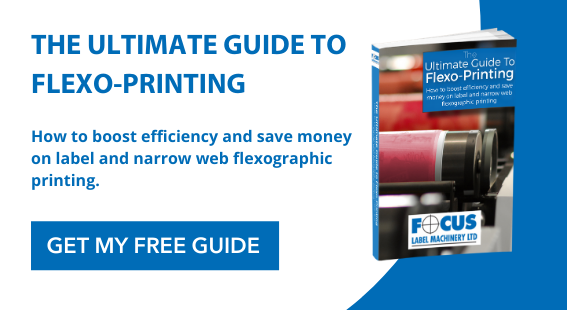Everything You Need To Know About Flexo-Printing
How to boost efficiency and save money on label and narrow web flexographic printing
Introduction
Welcome to our page on Everything You Need To Know About Flexographic Printing! Flexography is one of the most versatile and efficient print methods available.
For label printing businesses, a flexographic printing press can help you:
- Cut down on wastage
- Eliminate or minimise returns
- Ensure accurate print registration each time
- Save production costs
- Reduce print cycle times
- Achieve on-time production
At Focus Labels, we have been making label printing machines for more than 35 years. Our custom-made printing presses are used by print businesses serving a diverse range of market sectors around the world, from print publishers, to food packaging, to bespoke label printers.

About Focus Labels
Focus Label Machinery Ltd was set up in 1981, so at the time of writing (2016), we have just celebrated our 35th anniversary of continuous operation as a business. We’ve learned a thing or two about label printing in this time, and so feel ourselves qualified to offer some guidance and free advice to other businesses operating in the industry. Our background before we started Focus was in manufacturing print machines for the narrow web label and packaging print industry, a sector in which we had already accrued more than 30 years previous experience.
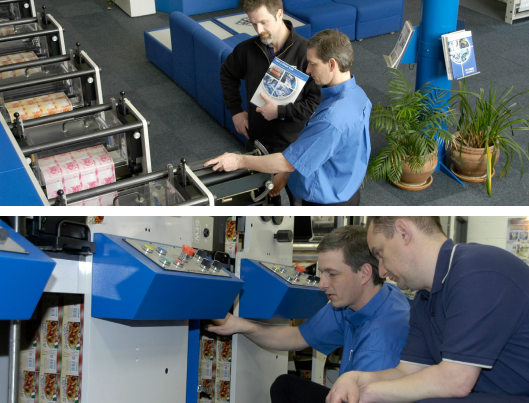
Improving Efficiency Through Innovation
Printing technology has moved on quite a bit since 1981; and we have become one of the world’s leading manufacturers of narrow web printing and converting, with clients all over the world. We are an established name in the industry, placing a strong emphasis on innovation to continually improve the performance of our print machines.
We try and set the high standard’s for other manufacturers to follow, with ongoing investment in research and new product development. In a competitive global environment, our commitment to develop & integrate new technology and our team of highly experienced support technicians gives our clients the edge in minimising wastage, reducing costs and completing assignments on schedule.
It’s fair to say that we are proud of our achievements including a number of product patents. Our latest advanced label printing technology allows the fastest colour changes on any press on the market today, with less downtime, less wastage, faster production, higher output and improved quality. This is no small boast, but it is one that is played out time and again in the efficiency savings and improvements enjoyed by our customers. We’d be delighted to answer any questions you might have and talk to you about how our flexographic label printing machines can help transform your business.
Do feel free to give us a call at our UK office on 01949 836 223.

100% UK Quality Guarantee
While outsourcing is common in the industry every machine is 100% designed , manufactured, and assembled in our UK facility, with a full guarantee of quality and ongoing support from our team of expert engineers. We also partner with the leading technology companies to integrate the latest digital & transmission& automation systems. There are a number of good reasons why we do this, which we will go into in more detail in the ensuing chapters
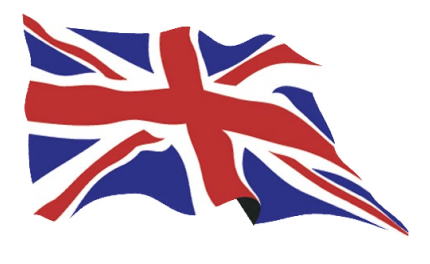
How Flexo-Printing Works
The ideas behind modern flexography – or flexo printing – are old ones, having their roots in the letterpress printing techniques first developed in the 1440s by Johannes Gutenberg. Of course, a lot has changed in the last 600 years, but print historians will be able to see the imprint of history in even the most advanced flexographic printing machines.
The first flexographic printing presses were developed in the 1890s in Liverpool and have undergone many incarnations since. What makes flexo printing so versatile and popular is its ability to print on almost any flexible substrate material. This includes paper, cellophane, metallic films and plastics – thus making it ideal for printing food packaging and product labels.
Flexographic printing presses are also extremely efficient and costeffective. A modern press can print at a rate of up to 400m per minute, a phenomenal speed compared with some of the alternatives, such as lithographic presses or digital printing. It also has the advantage of using a variety of Ink types such as Water based, Solvent & UV Inks which makes it ideal for almost every application including those having a high level of health & safety obligations such as food packaging.

The Flexo-Printing Process
There are thousands of different types of flexographic printers available, with the best ones currently being made in the UK, Europe and the USA. Each machine shares a common printing process, so if you are familiar with one flexo machine you will be able to understand them all. The key parts of the process are explained below:
Platemaking
The most important element of flexography is the printing plate, which contains the images and text to be printed in negative as a mirror image. A separate plate needs to be made for each colour used in the print run.
Platemaking is an art and science all of its own. There are three main methods that have been used historically:
1) Metallic plate etching/Rubber Plates: The print image is first etched in negative onto a metal plate made of zinc or magnesium, which is then washed in an acid bath. The image will appear in bas relief on the plate. A second stage creates a plastic mould, which is then utilised to fashion the final printing plates out of a flexible, thermoplastic polymer. This is an expensive and time-consuming method which is rarely used these days.
2) Photo etching/ Photopolymer Plates: The print image is etched through a photo negative directly onto a light-sensitive polymer plate by means of ultraviolet light. When the polymer hardens, it is then washed out in a bath of water or solvent, at a temperature of about 40°C. This is still the most common system of flexo plate production today.
3) Digital platemaking/Digital Plates: This most modern method uses a digital image to direct a computer operated laser to etch the printing plate. This eliminates the need of a photo negative and is now the fastest growing technique for platemaking applications.
Printing
To begin the print process itself, the printing plate is loaded into the printing press on Plate cylinders. As each colour needs a separate plate, it is essential that the plates are mounted correctly on the press, so that the images are transferred to the substrate accurately. Most print presses use specialist video assisted mounting machines to make sure every plate is aligned & positioned appropriately.
When the run is due to begin, Ink is transferred from the ink tank through a fountain or metering roller, and then on to an anilox or ceramic roller. This regulates the deposit of ink onto the printing plates and ensures an even coverage of Ink. The anilox roller is a fascinating piece of kit. Its surface is covered with thousands of tiny, cell -like impressions that act like tiny ink cups.
To avoid ink flooding or patchiness, a doctor blade, or scraping tool is used to clear the anilox roller of excess ink. This prevents smudging when the plate is driven through the impression cylinder to make contact with the substrate. The result is a positive print image (from the negative print plate).
When the printed image is transferred to the substrate, the Ink needs to dry as quickly as possible. This can be affected through fan powered Infra red dryers, or by ultraviolet (UV or LED) curing, depending on the Ink type used.

Understanding The Key Flexographic Label Printing Press Components
As well as following a broadly similar process, all flexographic printing presses have a similar suite of components. These are: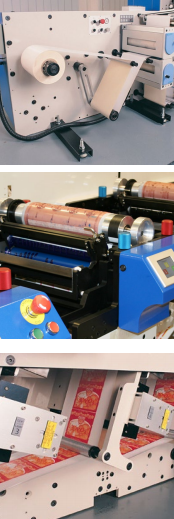
Feed & Unwind Station: Control of the substrate is essential, feeding it into the press at a pre-defined tension , constantly even as the diameter of the roll changes . The unwind system should have automatic web guides and options for web cleaning and Corona treaters for synthetic substrates.
Printing station: The print station needs to provide a smooth & stable drive to ensure the printed image is clean & vibration free. The basic Flexo systems includes an Ink storage tank , one or more fountain/metering rolls , Anilox Roll & Plate Cylinder . As we saw above, The ink is picked up from the tank by the metering roll which wets the anilox Roll and then ink transferred to the plate cylinder which holds the printing plates, and then onto the impression cylinder which carries they substrate, the image is transferred from the plate to the substrate before repeating the continuous process. Together, the two cylinders are sometimes known as the print anvil.
Drying Station: each colour should be dry before the next is applied to the substrate. The drying section might include a combination of Infrared & Air drying or UV / LED curing or both systems. Better machines will ensure the drying intensity is matched to the press speed which can be variable with different applications.

Chilling Rollers: with a growing use of ever thinner synthetic and unsupported films there is a need to control the web temperature to ensure the substrate remains stable through the press. This is even more critical where using UV drying system which inherently create a lot of heat . The addition of chill rollers provide that control.
Die Cutting & Converting: these are more commonly found on narrow web presses for production of labels, tickets & cartons. Products can be cut, creased, Foiled, Stamped, Embossed, perforated all in line in the same operation as printing. Therefore producing the finished product or label in roll or sheet form. Die cutting modules need to be built with heavy duty components for the high levels of pressure/force required to convert flexible webs up to 300gsm.
Outfeed and Rewind: The output section maintains tension as the substrate leaves the printing press, by means of tension control sensors. Waste products are rewound out of the system and the final products are rewound into large rolls for later inspection.
Types of Flexographic Label Press
With these core processes and components in mind, it is time to introduce you to the three main types of flexographic label press. The right choice for you will depend on your print .
1) In-Line Press
Suitable for narrow web and mid-web printing, the sturdy in-line press is a popular choice for printing on a range of substrates. Individual colour stations are stacked in line horizontally from front to back. In –Line presses are very versatile and can integrate new technology with greater ease than the other systems we will look at. In-line presses are great for wider width printing. Reverse-side printing is made easy in some machines by turning bars that rotate the substrate without having to change the print cylinder. A variety of additional processes can be added in combination with flexo to add value to a printed product such as Foil blocking, Cold foil, Laminating.
2) Central Impression Press
Central Impression Presses are suitable for narrow web printing and are the most commonly used flexographic print machine for unsupported substrates . Typically 4 to 10 colour stations are possible , but instead of arranging them in line, each colour is positioned as a satellite around the main Central Impression cylinder. The Central cylinder can be over a metre in diameter. These types of machine have an advantage of being compact if space is an issue. They also provide very stable register on all types substrates. They are not as efficient as in-line presses or as operator friendly. Printing on both sides of the substrate may involve reducing the available printing width by 50% .
3) Stack Press
Stack presses provide the advantage of a compact footprint like the CI press . They are however the black sheep of the flexographic printing family being difficult to operate a stack of four to eight vertical colour stations and requiring a ladder to get to the upper print stations. The substrate follows on a snake like journey through the stack; the colours being imprinted on the substrate as it is passes through each station. This makes it difficult to monitor production quality during a long print run .Stack presses can comfortably handle most supported webs but are not suitable for unsupported materials.
Is Flexo Printing Suitable For Your Business?
Now we have gone through the main processes and technologies used in flexographic printing, it is time to explore whether or not it is the best option for your print business. Before we look at the different options available to you – both with flexo print and its alternatives – we will spend the next section exploring realistic budgeting, and how much you should expect to pay.
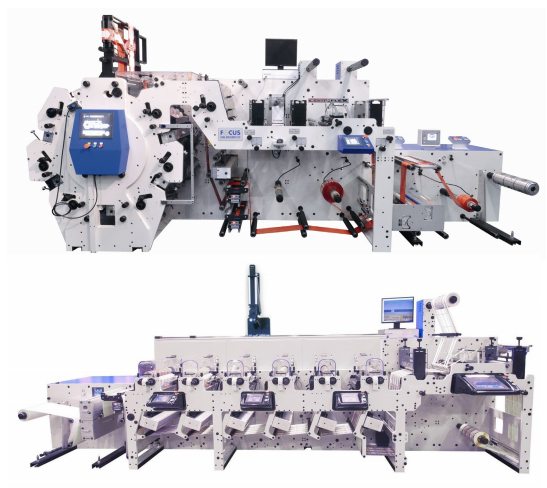
Setting A Realistic Budget
Setting A Realistic Budget Because flexographic label printing presses are reasonably complex and large machines, they inevitably involve a considerable investment. This is understandable when you consider all the variables that go into flexo printing, such as the precise mounting of print cylinders. Any inefficiencies in the process or defective components can have a negative effect on the quality of the print run. These can result in increased wastage, increased returns, inaccurate print replication and overall reductions in quality.
So when planning an investment in new flexographic equipment, what sort of budget should you be working towards? This is an open question with lots of variability, so first we will look at factors that affect the market value of flexographic label presses.
Factors Affecting The Price Of A New Narrow Web Flexographic Label Press
Number of colours: The more colour options, the more expensive the press will be.
Web width: To print wider labels, a larger impression drum is required, thus adding to the unit cost.
Type of drive system: The more technologically advanced the print drive system, the more it will cost. Your options relate the level of technology & components are involved in the drive. A non-servo drive will operate manually on an open loop system with some simple automated components, whereas a full servo drive is a closed-loop system with more extensive technology options. It will monitor feedback signals from the press and make automatic adjustments to maintain tension, register, and print speed. A partial servo drive has some, more limited feedback options, but not as many as a full servo drive.
Type of drying system: As discussed earlier, print can be dried through high-pressured air , Infrared or ultraviolet curing. Some presses also use LEDs to fix the ink to the substrate. LED & UV systems are more expensive than IR and fan powered systems, although LED may have lower energy requirements and thus cost less to run.
Level of automation: Modern printing presses can be very sophisticated, with high levels of automation. For print businesses this cuts back on manpower requirements and can make your production line more efficient, but it will involve a larger initial investment.
Optional equipment: additional equipment, such as Web Cleaners, Corona Treaters, Video inspection systems , conveyor systems, will increase the amount of money you need to spend on the press. Have a clear idea of essential features you need. Don’t overload your specification with options you may never use.
Average Price Ranges For New Machines
The prices for new machines vary considerably, depending on their size and features, so these estimates should only be taken as very loose averages. Nevertheless, they do give an indication of how much you should expect to pay for a new flexographic print machine. If you receive a quote that is significantly lower or higher than these figures then it is wise to treat it with some scepticism. Find out from the manufacturer what additional features or cost savings justify the price.
Six colour presses: Price range varies from £100,000 up to £450,000 for large machines. An average investment would be £150,000- £295,000.
Additional colours and specialist applications: Investment price starts to rise as more colours and specialist applications are added. A non-standard or high level specification press could cost in excess of £600,000.
Is there a cheaper alternative?
In the two sections that follow we will look at two money-saving alternatives to buying a new, British-made press. However, we cannot emphasise enough that simply looking for the lowest quote is a false economy.
Instead of looking at the cash figure of your initial investment – which in most cases can be attained through credit – it is more realistic to view your purchase in terms of ROI. So long as you purchase a print press that closely matches the requirements of your business, then the resulting increase in productivity and sales output will soon make your investment worthwhile.
Second Hand or Refurbished Machines: The Pros and Cons
Second Hand or Refurbished Machines: The Pros and Cons
While new printing presses are now the industry standard, there are plenty of second-hand machines available for those who look. As print technologies have advanced rapidly over the past few years (especially in terms of digital platemaking and print Servo automation), the market has become flooded with second-hand and refurbished machines. Do these offer true value for money?
Advances In Print Technology & Credit Availability
There was a time when print technology didn’t change all that much from one year to the next, so that buying a 10-year-old, secondhand press wasn’t much of a risk. This isn’t the case anymore, now that emerging print technologies can give businesses a significant technological advantage over their competitors.
Additionally, it wasn’t always easy to get credit to purchase new machines, whereas finance is now easily available. New machines are therefore more widely accessible to a greater number of businesses than they were previously. This has resulted in a decline in the number of businesses buying second hand machines.
In the interest of balance, we have to say that if initial investment is your only consideration, then you probably will save money by buying a second-hand machine. However, there is a strong chance that your second-hand press will be technologically obsolete before it is even installed. New equipment offers the benefit of the latest technology; with better print quality, quicker set-up & job changes, greater energyefficiency, higher productivity, less wastage, less downtime and less operator stress.
With this caveat, here are the advantages and disadvantages of buying second-hand…
Disadvantages
- Obsolete technology: Second-hand printing presses are unlikely to have the same richness of automation options and energy efficient drivers that new presses do.
- Underlying technical issues: A risk you take when buying second-hand are the underlying technical issues that many old machines have. These may not be apparent at first but may suddenly appear after only a few print runs.
- Spare parts rare or unavailable: It can be difficult to obtain spares & replacement parts for older, used equipment – especially electronic components, which can be expensive if original versions have become obsolete.
- No capacity for upgrades: Similarly, it may not be possible to expand the capabilities of an older press, exacerbating the problem of obsolete technology.
- Specification: if you have any special requirement it is unlikely you will find a used machine in the exact specification & condition you need.
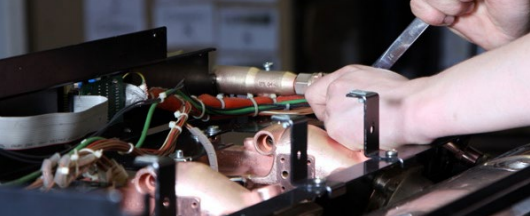
Advantages
The only significant advantage we can think of with second-hand machines is the lower upfront cost. Depending on the manufacturer, the age of the machine and the availability of spare parts, you could pick up a flexographic printing press at a fraction of the going rate for a new machine. For small businesses this can be an attractive option.
If you already have a similar machine purchasing another may be seen as a good case for a back-up, and you will already know the limitations or problems associated with that model of machine.
Second hand machines are also popular (or used to be) with businesses who wanted to make an outright capital investment without taking on additional debt.
New machines often have long lead times, if time is critical the only option may be to find a used machine. However you will need to be flexible with regards to specification.
The Best Investment Decision
The decision is yours, but on balance most print businesses find that a new machine is a better investment. They work better, are cheaper to maintain and are subject to fewer faults and defects than older models. Second hand presses have a shorter working life than new models – and may ironically end up costing you more throughout their lifecycle than a new press.
If you do choose to purchase a second hand press, it is vital you make sure that spare parts are abundantly available and you have a good service plan in place. Will the dealer take care of transport & commissioning. Is there any warranty ..? who do you contact if it goes wrong…? Dealers are often merely just a broker and simply middle men linking buyer & seller. Finally don’t simply hand over your money without guarantees in place. Always contact the original manufacturer, they will often have the machines service record and may be able to offer technical support. Ask about spare parts and recent service work if any..?
UK, USA or Far-East Manufacturer: Getting the Best Value
Getting The Best Value
If it is no longer feasible or cost effective to save money on a secondhand printing press, what about cheaper new machines? A lot of businesses now turn to cheap manufacturers based in China, South Korea or Taiwan. You can save money by going down this route, at least in the short term. But in order to explain why this is not always the best idea, we’d like to give a brief overview of the label printing machine industry as it stands.
British, American and European Presses
The heartland of innovative flexo printing has always been the UK , Europe and America. It was British companies who first developed the modern flexo printing process and American businesses who pioneered the printing of food packaging in the 1940s. US giants such as Kodak and AV Flexologic continue to lead the way in the field of digital platemaking technologies, while on our side of the pond, Focus and companies like us work on designing faster, more versatile and energy efficient printing hardware. Germany, Italy and the Netherlands also have an advanced print machinery industry.
Far East Presses
The Far East industries produce a lot of flexo presses. Many of them are attractively marketed and available at low prices. However, they all seem to be copies of American and European designs; reverse engineered from design brochures. They vary widely in quality. Some are better than others, but there isn’t any real way of verifying this before you purchase. Build standards and component quality are lower than British, American or European equivalents. After sales service and technical support is usually non-existent.
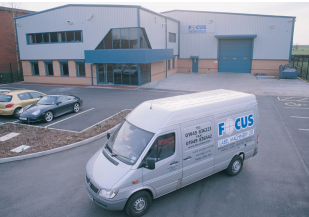
Getting The Best Value
The dangers of subcontracting
The risk of purchasing a cheap press from the far east comes from the common practice of subcontracting all aspects of the manufacturing process to a variety of different businesses in Asia. From the perspective of the end-user, it is impossible to verify quality or keep check on all these sources. This explains the inconsistent quality experienced by customers of these manufacturers, even for ones with a reasonable reputation. You may be lucky and get a press that works well, or on the other hand you may not.
Long term ROI
Once again, with affordable finance available to suit most budgets, upfront cost isn’t the most important factor at stake. Instead of thinking about how much money could be saved by purchasing from Asia, it is better to look at how much additional value you could get by buying from a known manufacturer. Firstly, with a UK manufacturer you will have direct access to the manufacturing workshop. Secondly you have a support team at the ready, within your time zone, if you need advice, troubleshooting or training. Finally, you have peace of mind that your press is manufactured to high international standards with the best components available on the market – and assembled by trained, professional engineers. This is why you will get the best long-term return on investment by buying British, even if it might cost you a bit more to begin with.
Alternatives to Flexo-Printing
When reviewing your options, you may like to examine alternatives to flexo printing. Some magazine, book and newspaper publishers still use lithographic printing presses, but for label printers the only real alternative is digital printing. In this section we will give a brief overview of digital printing and how it compares to flexographic printing.
Digital Printing
Digital printing was first put to commercial use in 1991, but has still not been widely adopted by the industry. Putting Convenience aside this is because, compared with flexo print, digital is still relatively expensive and not economical for medium to high volume production. Although digital printing technologies are improving all the time and there are some advantages, for large-scale, commercial printing businesses, flexographic printing is hands down still the most cost-effective option.
Cost comparison
Some label printing businesses are attracted to digital equipment for initial cost reasons. Indeed some Digital printers can to be less expensive than flexographic machine. A digital printing press does not have to contend with all the rollers, print plates, cylinders, mechanical drivers and dryers that constitute a flexographic printer. So you will pay less upfront for a digital machine. However, this is where the savings end. Unit per unit, digital printing is far more expensive than flexo. If you are doing large print runs it is more cost-effective to go flexographic.
Print cycle
On the surface, digital printing has the advantage in terms of print turnaround time. To use a digital printer, it is essentially a matter of selecting some files and pressing go, whereas flexo printing involves filling inkwells, resetting drivers and creating print plates. For small print runs of 2,000 labels or less you will save time compared with flexo. However, when processing medium & large print runs, the time required to set up a flexographic press is insignificant. Once up and running, flexo print machines will run far more quickly and efficiently than their digital cousins.
Ink and substrate
Flexographic printing gives you far more colour options and choices of ink than digital printing. You can use water-based, solvent or UV based inks in flexo, giving you enormous versatility. Flexo Ink tends are much cheaper to purchase too. Similarly, you have far more flexibility when it comes to substrate. Digital presses often require specially prepared substrates which are more expensive than standard materials. Digital printing lacks the capacity for printing in continuous runs, making it unsuitable for wallpaper, food packaging and most commercial labels.
Common Mistakes and How to Avoid Them
After examining the options, you may have decided that buying a new, British made flexographic printing press is the best option for your business, and if so we would like to congratulate you on making a great choice!
However, before you choose a manufacturer you should be aware of four common mistakes that businesses make when buying a printing press.
1) Not prioritising the important features
New printing presses come with so many ‘bells and whistles’ that it can be difficult to prioritise the features you actually need. A big mistake people make is to over specify the features, to include lots of optional extras which end up hardly being used. This bumps up the price of the press. Worse still, these extra features are often selected at the expense of important features, such as a higher number of colours or wider web width.
2) Choosing the cheapest option
Even when choosing a new machine there is the natural temptation to favour the cheapest option. This isn’t always the best decision, as cheaper machines often come with fewer features, reduced energy efficiency and longer set up times & lower production speeds.
3) Insufficient product testing
Before you buy a printing press you should be fully aware of how it’s going to be used and the materials it is intended to work with. Choose a machine to match your output, rather than trying to adjust your requirements to match the machine. Importantly, the machine needs to work with the substrate you will be printing on, whether this is paper, cellophane or wallpaper. A big mistake companies make is to not fully test the press for suitability before purchase.
4) Skimping on training
Flexographic equipment are complex pieces of kit and involve a learning curve. Operators should be given enough time to be fully conversant with the machine before it is put into active use. Not allowing enough time for proper training after installation increases the risk of product wastage and damage to the press through human error. This is why at Focus we put such a strong emphasis on training and technical support – both before and after installation.
Benefits of Buying From Focus
Investing in a high quality flexographic press, with the right consumables and strong technical support, is the best way of guaranteeing on-time production and consistent quality across your print runs.
At Focus, we believe we have the right combination of expertise, professionalism and creativity to provide you with the flexographic solutions you need. With every build we combine cutting-edge design, high engineering standards and after sales support to help you get the best return from your investment.
These are what we feel are the five main strengths of our business model that set us apart from our competitors, both in the UK and abroad.
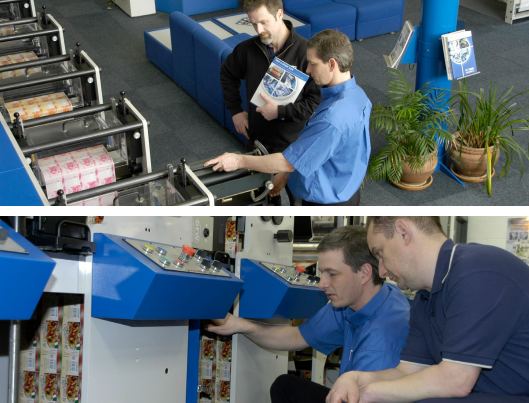
1) Engineering and build quality
All our printing presses are designed, engineered and assembled at our facility here in the UK. We don’t outsource any part of the process, so when you visit our workshop – which you are very welcome to do – the engineers you meet are the same people who will be working on your machine. This is how we combine cutting-edge technology with personal service, and is one of the main benefits of buying from a UK manufacturer. We are always available to answer your questions and field your calls throughout the process.
Our presses have a professional reputation for extreme reliability while also being versatile and cost-effective. As technologies change, we will be able to update your press with upgraded modules, so you can maintain your competitive edge. All our designs are future proof in this way, to guard against obsolescence and give you greater long-term value for money. Every press comes with full build quality assurance and product warranty.
2) Reliable components
We sometimes use third-party suppliers to provide electrical components, such a servo drives, control systems, gearboxes and UV systems. We are completely transparent in this and only ever use reputable UK and European supply partners. We never try to cut corners by sourcing electrical components from the Far East.
3) Innovative R&D Department
A print business that fails to innovate rapidly falls behind its competitors. We are therefore always working to give our customers a technological edge by innovating new products and components to improve the performance of our printing presses. We never simply replicate what other companies are doing, but instead try to lead the field ourselves by approaching problems in a new way
4) Custom solutions
We manufacture a range of market leading printing presses that can be ordered, manufactured and installed within a short turnaround time. However, we are not in the business of selling ‘off-the-shelf’ presses. Every one of our products can be customised and upgraded to suit your unique requirements. We can also provide tailored & bespoke solutions for nonstandard applications. Simply get in touch with one of our team to discuss your requirements and find out more.
5) Excellent technical and after-sales support
We pride ourselves on our excellent technical support and after sales customer service. Wherever in the world you are based, we can offer you fast, expert support through our global network of representatives and distributors. Our rapid response service gives you access to spare parts and engineering services whenever you need them.
Our support begins even before installation, with our comprehensive training package. We want to ensure that all your team are completely confident in operating your new press so you can start running at full efficiency straight away. We therefore offer full training as an inclusive service. We have a showroom at our Nottingham headquarters that features working models of all of our presses, so if it is convenient for you we can host your team here for a full demonstration.
Alternatively, we can carry out your training at your location. Simply let us know what works best for you. You can drop into our showroom at any time for top up training or to speak to one of our engineers. It is always good to meet our customers face-to-face!
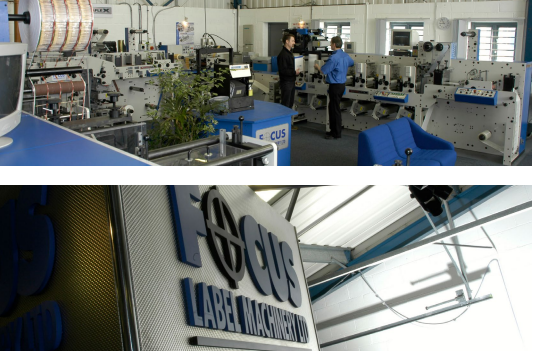
Find Out More
Many thanks for taking the time to read this page. We hope you have found out a few new things about flexo-printing and will give serious consideration to ordering a new press from Focus.
If you would like to discuss any of the issues raised, or have questions about our products or services, please do not hesitate to get in touch with a member of our experienced customer service team.
We would be delighted to meet you in person and show you around our manufacturing facility.
For a quote to suit your budget, please give us a call on 01949 836 223 or send us an email to admin@focuslabel.com


